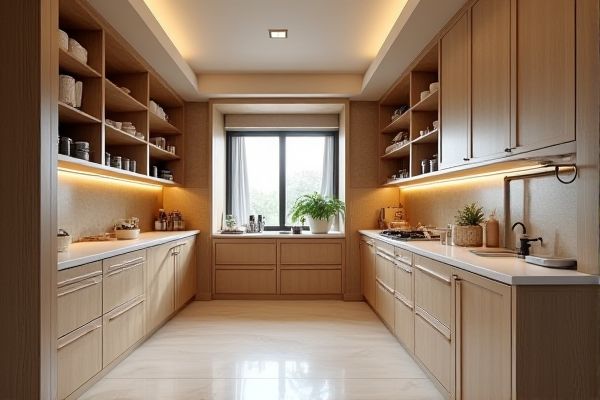
G-shaped pantries maximize storage space with additional countertop and shelving areas, ideal for organizing various kitchen essentials efficiently. Explore the rest of this article to discover which pantry layout suits Your kitchen needs best and enhances functionality.
Table of Comparison
| Feature | G-Shaped Pantry | L-Shaped Pantry |
|---|---|---|
| Layout | Three connected walls forming a "G" with an additional peninsula or partial wall | Two connected walls forming an "L" |
| Storage Capacity | High, offers maximum storage with ample shelving and cabinets | Moderate, good use of corner space but less overall storage |
| Space Requirement | Requires larger floor area | Fits smaller or medium spaces |
| Accessibility | Efficient with organized zones but may feel enclosed | Open layout, easier access and movement |
| Ideal For | Large kitchens or homes needing extensive storage | Compact kitchens and open floor plans |
| Cost | Generally higher due to complexity and size | More budget-friendly and simpler installation |
Introduction to G-Shaped and L-Shaped Pantries
G-shaped pantries feature an efficient design with three connected walls forming a U with an extra peninsula, maximizing storage space and accessibility in compact kitchens. L-shaped pantries utilize two adjoining walls to create a corner storage area, providing ample shelving while maintaining an open layout ideal for larger spaces. Choosing between these configurations depends on your kitchen's size and storage needs, balancing ease of movement and item organization.
Key Design Differences
G-shaped pantries feature an extra partial wall, creating a more enclosed space with increased countertop and storage area compared to L-shaped pantries, which form a simple two-wall layout ideal for open kitchen designs. The G-shaped layout maximizes corner space and provides distinct zones for different pantry functions, while L-shaped pantries offer easier accessibility and a more open feel. Choosing between these designs depends on your kitchen size and preference for storage capacity versus open flow.
Space Efficiency and Storage Capacity
G-shaped pantries offer superior space efficiency by utilizing three connected walls, creating ample corner storage and minimizing unused areas for maximum shelving. L-shaped pantries provide a balanced storage capacity by combining two adjacent walls, ideal for smaller spaces but potentially leaving some corners less accessible. Choosing between the two depends on kitchen layout and the need for maximizing vertical and corner storage solutions.
Accessibility and Ease of Use
G-shaped pantries offer enhanced accessibility by providing ample counter and storage space on three sides, allowing you to reach ingredients and tools with minimal movement. L-shaped pantries maximize corner space effectively but may require additional organizational solutions to avoid hard-to-reach areas, impacting ease of use. Your choice depends on kitchen layout, with G-shaped designs favoring continuous workflow and L-shaped setups fitting compact or irregular spaces.
Aesthetic Appeal and Visual Impact
G-shaped pantries create a visually commanding and cohesive space by enclosing the area on three sides, offering a balanced and symmetrical aesthetic that enhances kitchen flow. The L-shaped pantry provides an open, airy feel with clean lines, contributing to a minimalist and modern look that visually expands the kitchen. Both designs optimize storage, but the G-shape delivers a more immersive and structured visual impact, while the L-shape emphasizes spaciousness and accessibility.
Customization Options
G-shaped pantries offer extensive customization options with their multiple walls and corners, allowing for a variety of shelving heights, built-in drawers, and specialized storage for large appliances. L-shaped pantries provide flexibility in utilizing corner space effectively, with custom cabinetry and adjustable shelving designed to maximize accessibility and organization. Both designs accommodate tailored solutions, but G-shaped pantries generally support more complex configurations due to their larger footprint.
Functionality for Different Kitchen Sizes
G-shaped pantries maximize storage in larger kitchens by offering extensive countertop space and multiple cabinet sections, ideal for accommodating a variety of appliances and pantry items. L-shaped pantries fit smaller or medium-sized kitchens more efficiently, optimizing corner space and maintaining open floor plans, which enhances accessibility and workflow. Your choice depends on kitchen size and layout, with G-shaped designs providing ample function for spacious areas, while L-shaped options deliver practical organization without overcrowding compact spaces.
Cost Comparison
G-shaped pantries typically involve higher construction and material costs due to their extended cabinetry and additional corner space utilization, often increasing both labor and installation expenses. In contrast, L-shaped pantries usually present a more budget-friendly option with simpler layouts requiring fewer cabinets and less intricate corner solutions, resulting in lower overall costs. Cost differences can also be influenced by the size of the space and choice of finishes, but G-shaped designs generally demand a larger investment compared to L-shaped pantries.
Pros and Cons of G-Shaped Pantries
G-shaped pantries maximize storage space with additional counter areas, making them ideal for large kitchens requiring extensive organization and multiple work zones. However, their complex layout can limit accessibility and may feel cramped in smaller kitchens, reducing efficiency. Compared to L-shaped pantries, G-shaped designs often involve higher costs and more intricate construction due to the extra walls and cabinets.
Pros and Cons of L-Shaped Pantries
L-shaped pantries maximize corner space, offering increased storage capacity and efficient organization for larger kitchens. Their design allows for easy access to multiple storage zones, but the corner area can sometimes be difficult to reach or underutilized without custom shelving. While L-shaped pantries provide flexibility in layout, they may require more floor space, making them less suitable for compact kitchens compared to G-shaped pantries.
 homyna.com
homyna.com